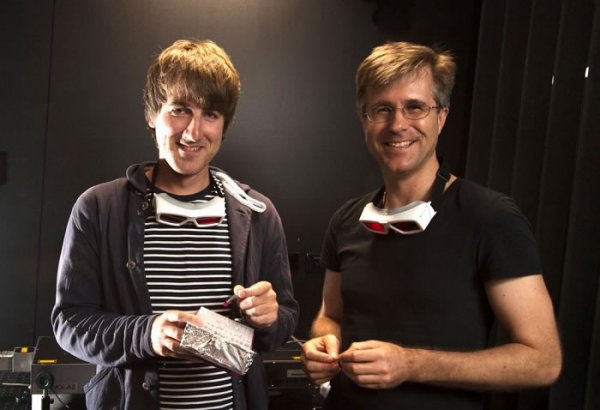An international team of scientists at Queensland University of Technology has just developed a new type of "dynamically reprogrammable" material based on light regulation, which is characterized by being able to harden under certain types of light and soften again in the dark. For applications such as 3D printing, this new material has great potential, such as temporary support for a complex structure. It is reported that this material is a masterpiece of scientists from Queensland University of Technology (QUT), Ghent University in Belgium, and Karlsruhe Institute of Technology in Germany.

(Photo from: QUT, via New Atlas)
The new material consists of a polymer structure that can change its structure according to light and then recover. (The picture above shows the research co-author Dr. Hannes Houck and the right is Professor Christopher Barner Kowollik)
The variable properties depend on the cheap compounds used in the material, among them the coupling molecule called 'triazolinediones' (triazolinediones) and the common ingredient 'napthalene' in moth repellents.
Combined with the above materials, a dynamic reprogrammable new material that can be made robust by only being exposed to green LEDs and the like is made. When recovery is required, the researchers only need to leave it in the dark for a period of time.
Interestingly, this material will harden again just by turning on the light again. And the material is not only at the extremes of softness and hardness, but can adjust the mechanical properties to a certain position in the middle.
Researchers say this ability is unique in materials science and runs counter to current chemical understanding. Usually you will use different wavelengths of light or additional thermal stimulation to destroy the polymer molecular chain grid.
But here, we use green LED lights to fix the material, otherwise it becomes soft and flowable in the dark. However, only need to turn on the light again, the material will continue to repeat its unique properties.

(Photo from: QUT, via ACS)
The research team called this new structure "light-stable dynamic materials", hoping to eventually spawn a new class of materials that will allow it to respond to light in a more useful way.
At present, this property has been used in 3D printing. Because the lamination process is very complicated, it is usually necessary to add a temporary support structure to prevent objects with vertical characteristics (such as bridges) from collapsing.
Details of this research have been published in the recently published "Journal of the American Chemical Society", originally titled "Reversible Polymer-Chain Modification: Ring-Opening and Closing of Polylactone".
The valve is a series of gas emergency Shut Off Solenoid Valves, specially designed as gas pipe breaker for emergency use. It can be connected with gas leaking detection sensor, fire alarm circuit or other intelligent sensor modules so that on site or remote shut down on gas supply (manually or automatically) is possible, hence ensuring the safety on gas usage. The valve features an auto-close when strong vibration is detected. After close, manual operation is required to turn on the valve. This feature meets safety regulations in the event of an accident.
Gas Solenoid,Solenoid Valve,Gas Solenoid Valve,Solenoid Operated Valve
Rictron Industrial Co., Ltd , https://www.szrictron.com